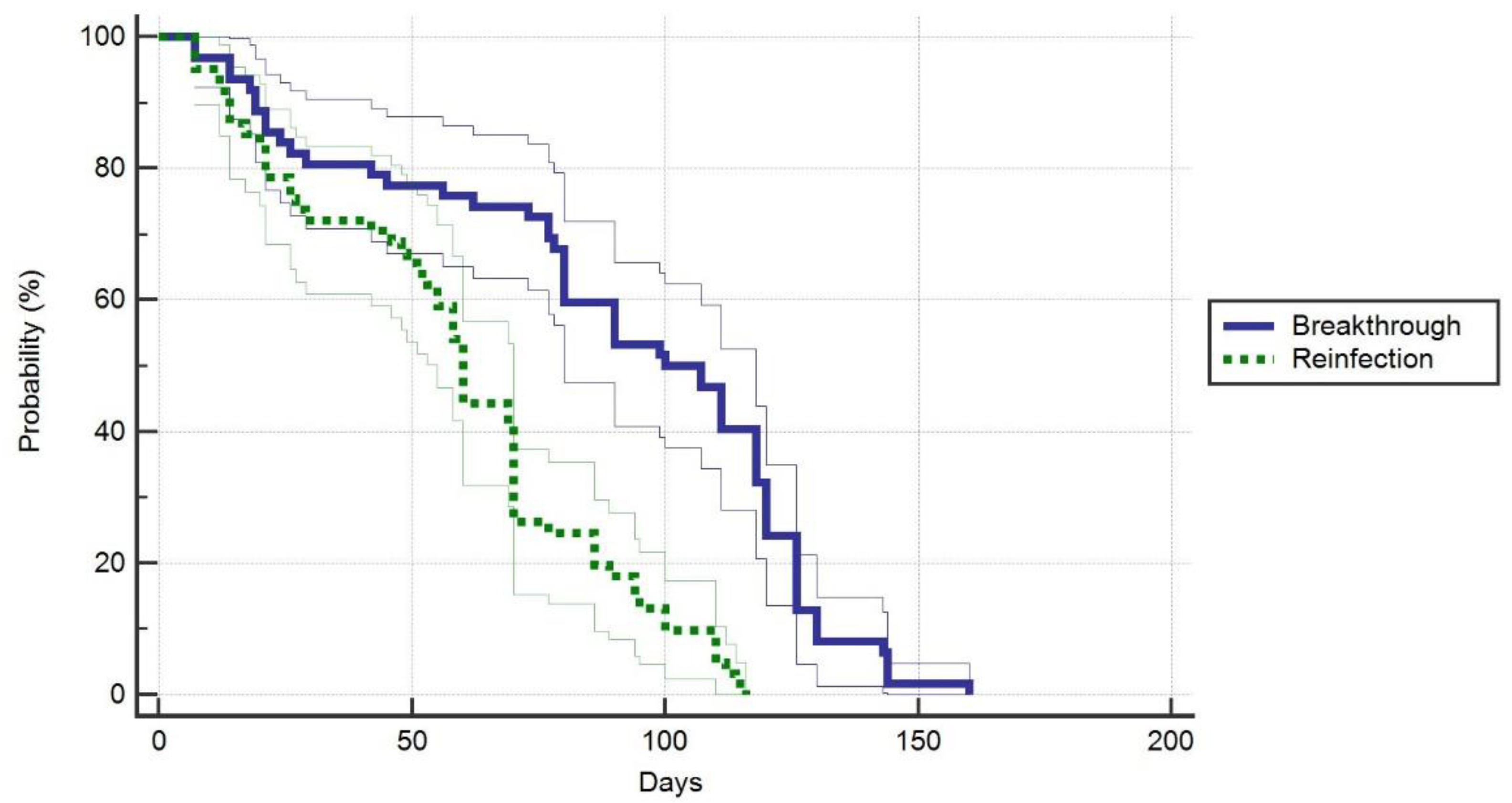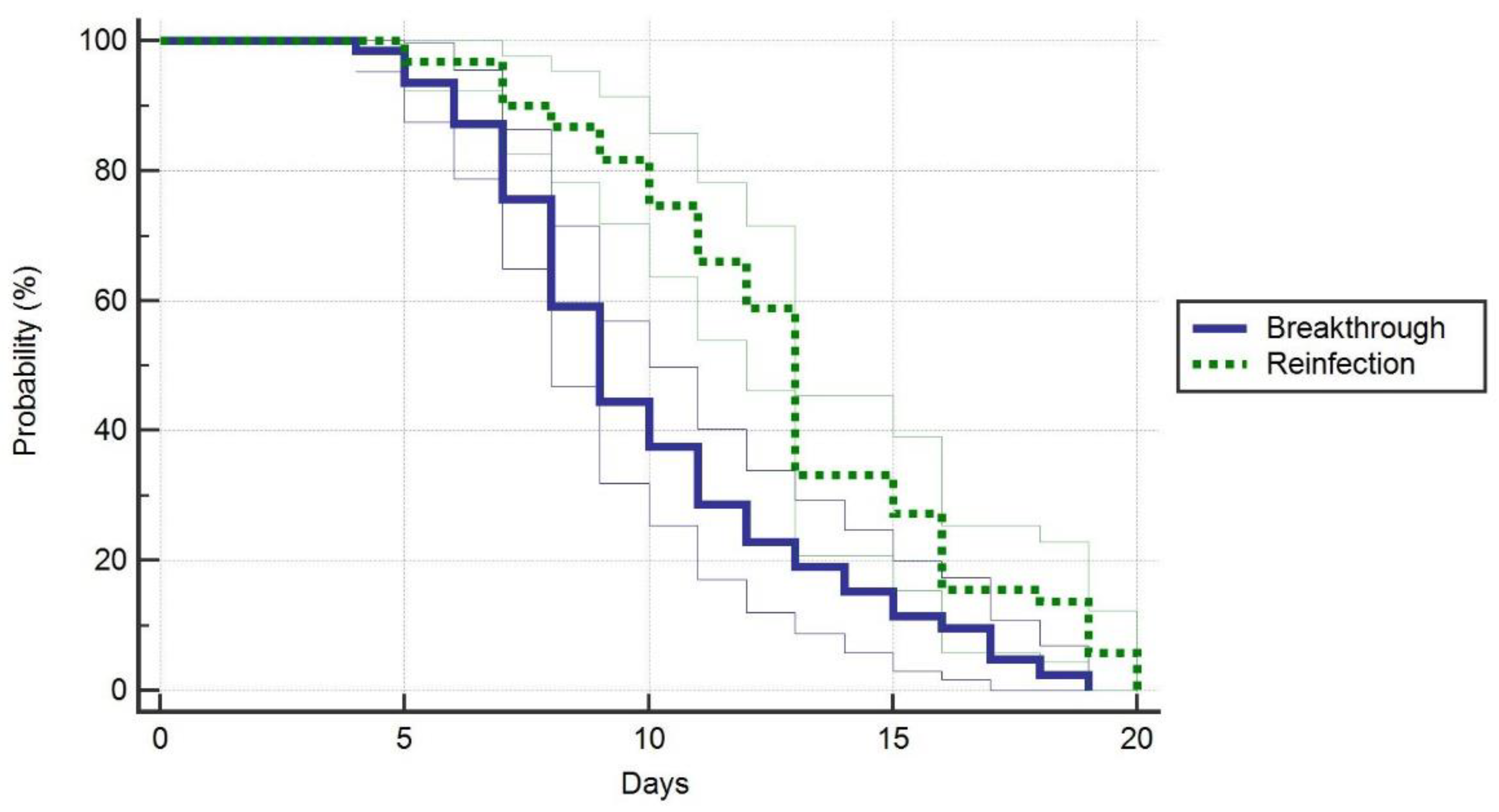Clinical Characteristics and Outcomes of COVID-19 Hospitalized Patients: A Comparison between Complete mRNA Vaccination Profile and Natural Immunity
Abstract
:1. Introduction
2. Materials and Methods
2.1. Design and Eligibility Criteria
2.2. Ethics
2.3. Statistics
3. Results
4. Discussion
5. Conclusions
Author Contributions
Funding
Institutional Review Board Statement
Informed Consent Statement
Data Availability Statement
Conflicts of Interest
References
- Cucinotta, D.; Vanelli, M. WHO Declares COVID-19 a Pandemic. Acta Biomed. 2020, 19, 157–160. [Google Scholar] [CrossRef]
- Polack, F.P.; Thomas, S.J.; Kitchin, N.; Absalon, J.; Gurtman, A.; Lockhart, S.; Perez, J.L.; Pérez Marc, G.; Moreira, E.D.; Zerbini, C.; et al. Safety and efficacy of the BNT162b2 mRNA COVID-19 vaccine. N. Engl. J. Med. 2020, 383, 2603–2615. [Google Scholar] [CrossRef] [PubMed]
- Haas, E.J.; Angulo, F.J.; McLaughlin, J.M.; Anis, E.; Singer, S.R.; Khan, F.; Brooks, N.; Smaja, M.; Mircus, G.; Pan, K.; et al. Impact and effectiveness of mRNA BNT162b2 vaccine against SARS-CoV-2 infections and COVID-19 cases, hospitalisations, and deaths following a nationwide vaccination campaign in Israel: An observational study using national surveillance data. Lancet 2021, 397, 1819–1829. [Google Scholar] [CrossRef]
- Petter, E.; Mor, O.; Zuckerman, N.; Oz-Levi, D.; Younger, A.; Aran, D.; Erlich, Y. Initial Real World Evidence for Lower Viral Load of Individuals Who Have Been Vaccinated by BNT162b2. 2021. Available online: https://www.medrxiv.org/content/10.1101/2021.02.08.21251329v1 (accessed on 10 December 2021).
- Baden, L.R.; El Sahly, H.M.; Essink, B.; Kotloff, K.; Frey, S.; Novak, R.; Diemert, D.; Spector, S.A.; Rouphael, N.; Creech, C.B.; et al. Efficacy and safety of the mRNA-1273 SARS-CoV-2 vaccine. N. Engl. J. Med. 2021, 382, 1851–1852. [Google Scholar] [CrossRef]
- Voysey, M.; Clemens SA, C.; Madhi, S.A.; Weckx, L.Y.; Folegatti, P.M.; Aley, P.K.; Angus, B.; Barnabas, S.L.; Bhorat, Q.E.; Bibi, S.; et al. Safety and efficacy of the ChAdOx1 nCoV-19 vaccine (AZD1222) against SARS-CoV-2: An interim analysis of four randomised controlled trials in Brazil, South Africa, and the UK. Lancet 2021, 397, 99–111. [Google Scholar] [CrossRef]
- Hacisuleyman, E.; Hale, C.; Saito, Y.; Blachere, N.E.; Bergh, M.; Conlon, E.G.; Schaefer-Babajew, D.J.; DaSilva, J.; Muecksch, F.; Gaebler, C.; et al. Vaccine breakthrough infections with SARS-CoV-2 variants. N. Engl. J. Med. 2021, 384, 2212–2218. [Google Scholar] [CrossRef]
- Dagan, N.; Barda, N.; Kepten, E.; Miron, O.; Perchik, S.; Katz, M.A.; Hernán, M.A.; Lipsitch, M.; Reis, B.; Balicer, R.D. BNT162b2 mRNA COVID-19 vaccine in a nationwide mass vaccination setting. N. Engl. J. Med. 2021, 384, 1412–1423. [Google Scholar] [CrossRef]
- Bates, T.A.; McBride, S.K.; Winders, B.; Schoen, D.; Trautmann, L.; Curlin, M.E.; Tafesse, F.G. Antibody Response and Variant Cross-Neutralization After SARS-CoV-2 Breakthrough Infection. JAMA: J. Am. Med Assoc. 2021, 327, 179–181. [Google Scholar] [CrossRef]
- Townsend, J.P.; Hassler, H.B.; Wang, Z.; Miura, S.; Singh, J.; Kumar, S.; Ruddle, N.H. The durability of immunity against reinfection by SARS-CoV-2: A com-parative evolutionary study. Lancet Microbe 2021, 2, e666–e675. [Google Scholar] [CrossRef]
- Graham, M.S.; Sudre, C.H.; May, A.; Antonelli, M.; Murray, B.; Varsavsky, T.; Kläser, K.; Canas, L.S.; Molteni, E.; Modat, M.; et al. Changes in symptomatology, reinfection, and transmissibility associated with the SARS-CoV-2 variant B.1.1.7: An ecological study. Lancet Public Health 2021, 6, e335–e345. [Google Scholar] [CrossRef]
- Teran, R.A.; Walblay, K.A.; Shane, E.L.; Xydis, S.; Gretsch, S.; Gagner, A.; Samala, U.; Choi, H.; Zelinski, C.; Black, S.R. Postvaccination SARS-CoV-2 infections among skilled nursing facility residents and staff members—Chicago, Illinois, December 2020–March 2021. Am. J. Transplant. 2021, 21, 2290–2297. [Google Scholar] [CrossRef] [PubMed]
- Nguyen, L.H.; Drew, D.A.; Graham, M.S.; Joshi, A.D.; Guo, C.-G.; Ma, W.; Mehta, R.S.; Warner, E.T.; Sikavi, D.R.; Lo, C.-H.; et al. Risk of COVID-19 among front-line health-care workers and the general community: A prospective cohort study. Lancet Public Health 2020, 5, e475–e483. [Google Scholar] [CrossRef]
- Williamson, E.J.; Walker, A.J.; Bhaskaran, K.; Bacon, S.; Bates, C.; Morton, C.E.; Curtis, H.J.; Mehrkar, A.; Evans, D.; Inglesby, P.; et al. Factors associated with COVID-19-related death using OpenSAFELY. Nature 2020, 584, 430–436. [Google Scholar] [CrossRef] [PubMed]
- Sudre, C.H.; Lee, K.A.; Ni Lochlainn, M.; Varsavsky, T.; Murray, B.; Graham, M.S.; Menni, C.; Modat, M.; Bowyer, R.C.E.; Nguyen, L.H.; et al. Symptom clusters in COVID-19: A potential clinical prediction tool from the COVID Symptom Study app. Sci. Adv. 2021, 7, eabd4177. [Google Scholar] [CrossRef]
- Sudre, C.H.; Murray, B.; Varsavsky, T.; Graham, M.S.; Penfold, R.S.; Bowyer, R.C.; Pujol, J.C.; Klaser, K.; Antonelli, M.; Canas, L.S.; et al. Attributes and predictors of long COVID. Nat. Med. 2021, 27, 626–631. [Google Scholar] [CrossRef]
- Dascalu, S.; Geambasu, O.; Covaciu, O.; Chereches, R.M.; Diaconu, G.; Dumitra, G.G.; Gheorghita, V.; Popovici, E.D. Prospects of COVID-19 Vaccination in Romania: Challenges and Potential Solutions. Front. Public Health 2021, 9, 644538. [Google Scholar] [CrossRef]
- World Health Organization. COVID-19—Romania Situation. Available online: https://covid19.who.int/region/euro/country/ro (accessed on 10 September 2021).
- Marincu, I.; Bratosin, F.; Vidican, I.; Bostanaru, A.-C.; Frent, S.; Cerbu, B.; Turaiche, M.; Tirnea, L.; Timircan, M. Predictive Value of Comorbid Conditions for COVID-19 Mortality. J. Clin. Med. 2021, 10, 2652. [Google Scholar] [CrossRef]
- Guvernul Romaniei. Actualizare Zilnica (10/10)—Evidenta Persoanelor Vaccinate Impotriva COVID-19. Available online: https://vaccinare-covid.gov.ro/actualizare-zilnica-10-10-evidenta-persoanelor-vaccinate-impotriva-covid-19/ (accessed on 11 October 2021).
- Office for National Statistics. Coronavirus (COVID-19) Infection Survey, Characteristics of People Testing Positive for COVID-19, UK: 6 October 2021. Available online: https://www.ons.gov.uk/peoplepopulationandcommunity/healthandsocialcare/conditionsanddiseases/bulletins/coronaviruscovid19infectionsurveycharacteristicsofpeopletestingpositiveforcovid19uk/6october2021 (accessed on 11 October 2021).
- Centers for Disease Control and Prevention. Vaccines & Immunizations—Interim Clinical Considerations. Available online: https://www.cdc.gov/vaccines/covid-19/clinical-considerations/covid-19-vaccines-us.html (accessed on 11 October 2021).
- Sui, Y.; Bekele, Y.; Berzofsky, J.A. Potential SARS-CoV-2 immune correlates of protection in infection and vaccine immunization. Pathogens 2021, 10, 138. [Google Scholar] [CrossRef]
- Wang, P.; Casner, R.G.; Nair, M.S.; Wang, M.; Yu, J.; Cerutti, G.; Liu, L.; Kwong, P.D.; Huang, Y.; Shapiro, L.; et al. Increased Resistance of SARS-CoV-2 Variants B.1.351 and B.1.1.7 to Antibody Neutralization. bioRxiv [Preprint Posted Online 4 February 2021]. Available online: https://www.biorxiv.org/content/10.1101/2021.01.25.428137v2 (accessed on 10 December 2021).
- Stamatatos, L.; Czartoski, J.; Wan, Y.-H.; Homad, L.J.; Rubin, V.; Glantz, H.; Neradilek, M.; Seydoux, E.; Jennewein, M.F.; MacCamy, A.J.; et al. mRNA vaccination boosts cross-variant neutralizing antibodies elicited by SARS-CoV-2 infection. Science 2021, 372, 1413–1418. [Google Scholar] [CrossRef]
- Butt, A.A.; Khan, T.; Yan, P.; Shaikh, O.S.; Omer, S.B.; Mayr, F. Rate and risk factors for breakthrough SARS-CoV-2 infection after vaccination. J. Infect. 2021, 83, 237–279. [Google Scholar] [CrossRef]
- Butt, A.A.; Yan, P.; Shaikh, O.S.; Mayr, F.B. Outcomes among patients with breakthrough SARS-CoV-2 infection after vaccination in a high-risk national population. EClinicalMedicine 2021, 40, 101117. [Google Scholar] [CrossRef] [PubMed]
- Butt, A.A.; Nafady-Hego, H.; Chemaitelly, H.; Abou-Samra, A.-B.; Khal, A.A.; Coyle, P.V.; Raddad, L.J.A. Outcomes Among Patients with Breakthrough SARS-CoV-2 Infection After Vaccination. Int. J. Infect. Dis. 2021, 110, 353–358. [Google Scholar] [CrossRef] [PubMed]


| Characteristics | Breakthrough Cases n = 62 | Reinfection Cases n = 62 | p-Value |
|---|---|---|---|
| General | |||
| Median age (IQR)—years | 51 (37.5–61.5) | 51 (37.5–61.5) | 1 |
| Male gender—n (%) | 39 (62.9%) | 39 (62.9%) | 1 |
| Obesity—(BMI ≥ 30 kg/m2) | 18 (29.0%) | 15 (24.1%) | 0.542 |
| Smoking, yes—n (%) | 20 (32.2%) | 17 (27.4%) | 0.555 |
| Days until second infection (mean ± SD) | 89.4 ± 42.3 | 58.6 ± 31.3 | <0.001 |
| Oxygen saturation on admission ≤ 92%—n (%) | 29 (46.7%) | 38 (61.2%) | 0.104 |
| Severe infection—n (%) | 11 (17.7%) | 16 (25.8%) | 0.276 |
| At-risk comorbidity count * | 0.044 | ||
| None | 19 (30.6%) | 16 (25.8%) | |
| 1–3 comorbidities | 17 (27.4%) | 30 (48.4%) | |
| >3 comorbidities | 26 (42.0%) | 16 (25.8%) | |
| Infection transmission | 0.003 | ||
| Family | 12 (19.4%) | 26 (42.0%) | |
| Colleagues | 12 (19.4%) | 16 (25.8%) | |
| No contact history | 38 (61.2%) | 20 (32.2%) | |
| Ground glass opacities | 0.162 | ||
| <30% | 17 (27.4%) | 11 (17.7%) | |
| 30–60% | 35 (56.5%) | 33 (53.2%) | |
| >60% | 10 (16.1%) | 18 (29.0%) | |
| Oxygen supplementation | |||
| AIRVO | 17 (27.4%) | 12 (19.4%) | 0.288 |
| CPAP | 12 (19.4%) | 23 (37.1%) | 0.028 |
| Ventilator | 10 (16.1%) | 15 (16.1%) | 0.263 |
| ICU admission | 11 (17.7%) | 16 (25.8%) | 0.276 |
| Days in the ICU (mean ± SD) | 12.2 ± 6.7 | 13.4 ± 8.6 | 0.387 |
| Mortality | 5 (8.1%) | 6 (9.6%) | 0.752 |
| Days until discharge (mean ± SD) | 9.8 ± 3.4 | 12.4 ± 3.8 | <0.001 |
| Outcomes (n, %) | Breakthrough Cases n = 57 | Reinfection Cases n = 56 | p-Value |
|---|---|---|---|
| Cough | 28 (49.1%) | 35 (62.5%) | 0.152 |
| Rhinitis | 16 (28.1%) | 20 (35.7%) | 0.383 |
| Chest pain | 5 (8.7%) | 6 (10.7%) | 0.727 |
| Dyspnea | 20 (35.1%) | 17 (30.3%) | 0.592 |
| Palpitations | 6 (10.5%) | 5 (8.9%) | 0.774 |
| Headache | 10 (17.5%) | 13 (23.2%) | 0.454 |
| Fever | 3 (5.2%) | 3 (5.3%) | 0.982 |
| Anosmia | 8 (14.0%) | 16 (28.5%) | 0.058 |
| Ageusia | 11 (19.2%) | 16 (28.5%) | 0.247 |
| Anorexia | 12 (29.0%) | 10 (17.8%) | 0.667 |
| Diarrhea | 3 (5.2%) | 5 (8.9%) | 0.447 |
| Myalgia | 14 (24.5%) | 11 (19.6%) | 0.528 |
| Insomnia | 21 (36.8%) | 18 (32.1%) | 0.599 |
| Anxiety | 18 (31.5%) | 19 (33.9%) | 0.790 |
| Depression | 10 (17.5%) | 14 (25.0%) | 0.332 |
| Factors | Odds Ratio (95% CI) | p-Value |
|---|---|---|
| Unvaccinated | 1.55 (CI = 0.91–2.67) | 0.061 |
| Age (>median of the study) | 3.31 (CI = 1.82–4.59) | <0.001 |
| Male gender | 1.04 (CI = 0.60–1.28) | 0.694 |
| Comorbidities (>3) | 1.57 (CI = 1.46–3.81) | <0.001 |
| Obesity | 1.13 (CI = 0.85–1.47) | 0.724 |
| Smoking | 2.33 (CI = 1.16–4.52) | 0.026 |
| Ground glass opacities (>60%) | 4.09 (CI = 2.10–7.55) | <0.001 |
| Oxygen saturation (<92%) | 2.66 (CI = 1.42–3.90) | 0.004 |
| Days until second infection | 1.87 (CI = 0.92–3.77) | 0.088 |
| Days in the ICU | 1.60 (CI = 0.70–2.19) | 0.195 |
| Mixed model * | 1.36 (CI = 1.02–3.83) | 0.001 |
Publisher’s Note: MDPI stays neutral with regard to jurisdictional claims in published maps and institutional affiliations. |
© 2022 by the authors. Licensee MDPI, Basel, Switzerland. This article is an open access article distributed under the terms and conditions of the Creative Commons Attribution (CC BY) license (https://creativecommons.org/licenses/by/4.0/).
Share and Cite
Marincu, I.; Citu, C.; Bratosin, F.; Bogdan, I.; Timircan, M.; Gurban, C.V.; Bota, A.V.; Braescu, L.; Grigoras, M.L. Clinical Characteristics and Outcomes of COVID-19 Hospitalized Patients: A Comparison between Complete mRNA Vaccination Profile and Natural Immunity. J. Pers. Med. 2022, 12, 259. https://doi.org/10.3390/jpm12020259
Marincu I, Citu C, Bratosin F, Bogdan I, Timircan M, Gurban CV, Bota AV, Braescu L, Grigoras ML. Clinical Characteristics and Outcomes of COVID-19 Hospitalized Patients: A Comparison between Complete mRNA Vaccination Profile and Natural Immunity. Journal of Personalized Medicine. 2022; 12(2):259. https://doi.org/10.3390/jpm12020259
Chicago/Turabian StyleMarincu, Iosif, Cosmin Citu, Felix Bratosin, Iulia Bogdan, Madalina Timircan, Camelia Vidita Gurban, Adrian Vasile Bota, Laurentiu Braescu, and Mirela Loredana Grigoras. 2022. "Clinical Characteristics and Outcomes of COVID-19 Hospitalized Patients: A Comparison between Complete mRNA Vaccination Profile and Natural Immunity" Journal of Personalized Medicine 12, no. 2: 259. https://doi.org/10.3390/jpm12020259
APA StyleMarincu, I., Citu, C., Bratosin, F., Bogdan, I., Timircan, M., Gurban, C. V., Bota, A. V., Braescu, L., & Grigoras, M. L. (2022). Clinical Characteristics and Outcomes of COVID-19 Hospitalized Patients: A Comparison between Complete mRNA Vaccination Profile and Natural Immunity. Journal of Personalized Medicine, 12(2), 259. https://doi.org/10.3390/jpm12020259









